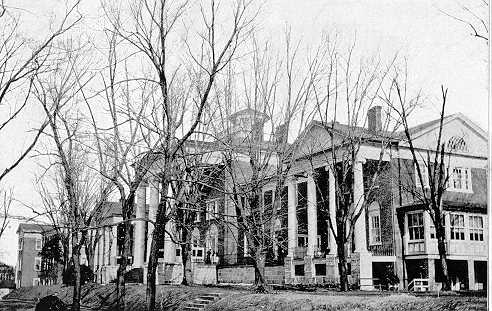Virginia
Number of victims
In total, 7325 individuals were sterilized in Virginia under
its sterilization law. Of those sterilized about half were deemed “mentally
ill” and the other half deemed “mentally deficient.” Approximately 62% of total
individuals sterilized were female. Some estimate the total number of sterilizations
as high as 8,300 individuals (Dorr 2006, p. 382).
Period during which sterilization occurred
Sterilization in Virginia occurred under state law
between
1924 and 1979. It thus appeared to have continued such sterilizations
longer than any other state (Landman 1932, pp. 83-4; Largent 2008, p. 80). There
are known instances of eugenic sterilization before 1924 (Dorr 2008, p.
116).
Temporal pattern of sterilization and rate of sterilization

Although Virginia formally adopted a sterilization
law in 1924, sterilization was not practiced widely until after the
United State Supreme Court ruling against Carrie Buck in 1927. This
ruling set a precedent on the legality of sterilization not only in
Virginia but also throughout the nation. During the 1930’s, immediately
after this Supreme Court ruling, sterilization in Virginia occurred at
its highest rate with approximately 13 sterilizations per 100,000 state
residents. A 1938 report stated that 632 of the first 1,000 patients
sterilized had been paroled, and that 812 of the same group were from
impoverished families (Trent 1994, 217). After the 1930’s – prior to,
during, and following WWII – sterilization initially decreased and
thereafter maintained a fairly constant rate. After this, sterilization
rates dropped dramatically until the practice faded out and then was
subsequently forced out of practice with the repeal of the 1924 act in
1974 and the additional removal of all mention of eugenic sterilization
to prevent “hereditary forms of mental illness that are recurrent” from
being passed on from Virginia code in 1979 (Dorr 2008, p. 221, Lombardo
2008b, p. 250). Compulsory sterilizations for non-eugenic purposes
continue today, but under very strict regulations. A compulsory
sterilization patient must be unable to give informed consent, in need
of contraception, unable to use any other form of contraception, and
permanently unable to raise a child (Lombardo 2008b, p. 267).
On March 20, 1924, Virginia SB 281, the “Eugenical
Sterilization Act,” was signed into law (Landman 1932, pp. 83-4).
Groups identified in the law
Under the Eugenical Sterilization Act, individuals confined to state institutions “afflicted with hereditary forms of insanity that are recurrent, idiocy, imbecility, feeble-mindedness or epilepsy” could be sterilized (Landman 1932, p. 84).
Process of the law
In order for a sterilization to take place under the 1924
Eugenical Sterilization Act the superintendent of a colony or hospital had to present
the case for each individual to be sterilized in the form of a petition to a
special board of directors at said institution. A copy of this petition was
also required to be presented to the patient and the legal guardian of the
patient. Thirty days after the board deemed an individual fit for
sterilization, the sterilization was permitted to occur. Appeals were heard but
rarely considered. No individual involved in this process could be held civilly
or criminally liable. Additionally, nothing in the Eugenical Sterilization Act
could prevent a legally licensed doctor from partaking in a medical procedure
that could “incidentally involve the nullification or destruction of
reproductive functions” (SB 281, Virginia Sterilization Act; (Landman 1932, p. 84).
Precipitating factors
and processes
The white, Virginia elite of the time was immersed in the
idea of perpetuating and protecting the purity of the “American race” (i.e.,
Anglo-Saxon Whites). This socioeconomic elite group wanted to maintain their
“traditional Southern identity” while also embracing modern progressive
ideology. The eugenic movement offered an avenue to pursue both of these
notions simultaneously. Through the embrace of eugenics as a progressive
science and ideology, Virginians were able to modernize their identity while
maintaining the purity of their state through the coerced sterilization of
minorities and undesirable whites alike (Dorr 2000, p. 262). Often, “mongrels” and
“worthless” whites were collected in “mountain sweeps.” This involved a sheriff
of a nearby town driving into mountain villages and forcibly removing
individuals and taking them to institutions where they would only be released
upon submission to sterilization (Black 2003, pp. 3-8). More often than not these
individuals were unaware of the consequences of the procedures that they
underwent.
“three generations of imbeciles are enough” (Lombardo 2003, pp. 2-4; Paul 1965, pp. 497-507).
On March 20, 1924 (the same day as the passage of SB 281, the “Eugenical Sterilization Act”) Virginia signed into law SB 219, the “Racial Integrity Act.” Under this piece of legislation it became “unlawful for any white person in [Virginia] to marry any [person] save a white person” (SB 219, Racial Integrity Act). The Racial Integrity Act garnered lots of public attention, allowing the Sterilization Law (written by Carrie Buck’s defense lawyer) to pass without much public notice (Lombardo 2008b, p. 100).
The Virginia sterilization law was
paramount to the perceived legality of sterilization throughout the
country. With the Carrie Buck Supreme Court case of 1927, the American
eugenics movement gained the legitimacy necessary to avoid adversity in
various courts (Paul 1965, p. 497). This ruling precipitated high rates of
sterilization in Virginia and throughout the rest of the United States.
This sterilization pattern continued throughout the first half of the
twentieth century until rates began to decline in the mid-1950s (Paul,
p. 504). In both 1956 and 1962, bills were proposed that allowed
for compulsory sterilization of women with multiple illegitimate
children. Both bills failed (Lombardo 2008b, p. 242-243). Furthermore,
with the issue of “Recommendation 6” of the Commission to Study
Problems Relating to Children Born Out of Wedlock in 1959, compulsory
sterilization was seriously questioned for the first time since its
legalization (Paul 1965, pp. 504-6). Even in the presence of such concern,
the 1961 report of the Virginia Advisory Legislative Council
recommended no change to the sterilization statute because there had
been “no substantial complaint” (Dorr 2008, p. 213). At this time every
other state in the Nation, with the exception of North Carolina, had
found reason to stop or slow sterilization (Paul 1965, pp. 506-9). Virginia
enacted additional voluntary sterilization legislation in 1962 (Windle 1965,
p. 307), which allowed women to volunteer to be sterilized as a birth
control measure (Lombardo 2008b, p. 243). In order to qualify for
voluntary sterilization, women needed to be married and to have
obtained spousal consent. Virginia’s current law, enacted in the early
1980s, only allows for those with a need for contraception, who have no
other options in obtaining it, to be sterilized. Patients can be
sterilized involuntarily, but the process one must go through before
gaining permission to involuntarily sterilize a patient is very
protective (Lombardo 2008b, p. 267).
Groups targeted and
victimized
After Brown v. Board of Education in 1954, racist eugenics became more prominent. The 1954 Supreme Court case brought a resurgence of racist eugenics called “Massive Resistance” to prevent desegregation (Dorr 2008, p. 196).
Racist eugenics once again came into discussion with the 1962 and 1964 proposed laws for punitive sterilization of welfare mothers with illegitimate children. There was some fear that African, Far eastern, Indian, and African American populations were expanding far more rapidly than others, and these proposed laws were in part to target such communities (Dorr 2008, p. 196, 211). Even with the voluntary sterilization law, there was some concern that a woman might consent to being sterilized if strongly advised by a physician to do so. This trust in physicians could have given them the power to influence women to undergo sterilization for ultimately eugenic purposes (Dorr 2008, p. 214).
Other restrictions placed on those identified in the law
On March 20, 1924 (the same day as the passage of SB 281, the “Eugenical Sterilization Act”) Virginia signed into law SB 219, the “Racial Integrity Act.” Under this piece of legislation to became “unlawful for any white person in [Virginia] to marry any [person] save a white person” (SB 219, Racial Integrity Act).
 (Photo origin: University of Virginia Health Systems' Claude
Moore Health Sciences Library, available
at http://www.hsl.virginia.edu/historical/eugenics/3-buckvbell.cfm)
(Photo origin: University of Virginia Health Systems' Claude
Moore Health Sciences Library, available
at http://www.hsl.virginia.edu/historical/eugenics/3-buckvbell.cfm)
After the 1924 act was passed, Priddy was a key proponent in the sterilization of a Virginia Colony patient, Carrie Buck, in order to test the strength of sterilization legislation and set a precedent of its legality. (The court case Buck v. Bell was originally Buck v. Priddy, however; Albert Priddy died before the case went into the appeals process and the Virginia Colony’s new Superintendent Dr. J.H. Bell replaced Priddy in the case during appeals.) Priddy’s power and eugenic ideology was a key factor in the success of eugenics throughout Virginia (Claude Moore Health Sciences Library).
While there were many major other proponents of eugenics and sterilization in Virginia, it is important to note the influence of Walter Plecker, the University of Virginia, and of the journal Virginia Medical Monthly. Walter Plecker, in his role as State Registrar at the Bureau of Vital Statistics, intended to maintain the purity of the states white race by classifying all residents in the state of Virginia by their race to prevent any intermarriage through the threat of prosecution of those who dissented (Black 2003, pp. 165-70). It was under the great influence of Plecker and his racist rhetoric that the Racial Integrity Act of 1924 became law (Lombardo 1996, p. 9).
Additionally, the University of Virginia acted as a highly respected educational institution that pushed the thought and science of eugenics through research and education. In the words of Dr. H.E. Jordan, Dean of the Department of Medicine at the University of Virginia, “eugenics… will work the greatest social revolution the world has yet known… [for] it aims at the production and the exclusive prevelancy of the highest type of physical, intellectual and moral man within the limits of human protoplasm” (Claude Moore Health Sciences Library). Having a similar influence, the Virginia Medical Monthly published medical reports from superintendents of various Virginia institutions as a method to increase the loathing toward those deemed feeble-minded while also spreading eugenics theory and practice. These proponents continued to condemn the “unfit” to sterilization and with their continual insistence of the necessity of sterilization, public support grew (Noll 1995, p. 61).
“Feeder institutions” and institutions where sterilizations were performed
 (Photo origin: University of Virginia Health Systems' Claude
Moore Health Sciences Library, available
at http://www.hsl.virginia.edu/historical/eugenics/3-buckvbell.cfm)
(Photo origin: University of Virginia Health Systems' Claude
Moore Health Sciences Library, available
at http://www.hsl.virginia.edu/historical/eugenics/3-buckvbell.cfm)
While Steven Noll noted in a 2005 article that the CVTC does not address its role in the 1927 Buck v. Bell case (p. 39), it does so now with remarkable candor about its past on its website under "History" (http://www.cvtc.dmhmrsas.virginia.gov/feedback.htm). Its cemetery is open to the public; however, archival material is not maintained in a manner that permits public viewing (Noll 2005, p. 37).
 (Photo origin: http://www.wsh.dmhmrsas.virginia.gov/images/photoofoldsite.jpg)
(Photo origin: http://www.wsh.dmhmrsas.virginia.gov/images/photoofoldsite.jpg)
Patients
were also sterilized the Western State Hospital in
Staunton, Virginia under the supervision of Joseph S. DeJarnette. The
hospital opened in 1825 as the Western Lunatic Asylum, but its name was
changed in 1894 to the Western State Hospital. Western State was the
second largest sterilization institution, after Lynchburg (Brocato
2008, p.
113). There is no mention of sterilization on any official webpages,
but the Western State Hospital still functions as a psychiatric
hospital.
 (Photo origin: http://www.gotghost.net/images/P3010134.JPG)
(Photo origin: http://www.gotghost.net/images/P3010134.JPG)
With less frequency,
sterilization occurred at Virginia’s Central State Mental Hospital in
Petersburg, which stopped treating intellectual disability patients in 1971,
but continues as a rehabilitation facility under the name Central State
Hospital.
 (Photo origin: http://en.wikipedia.org/wiki/Eastern_State_Hospital)
(Photo origin: http://en.wikipedia.org/wiki/Eastern_State_Hospital)
Sterilizations also took place at Eastern State Hospital in
Williamsburg, which is still functioning and claims to be America's
first psychiatric hospital, and at Southwestern State Hospital in
Marion as well (Black 2003, p. 4). Now a museum, the original hospital built in 1773 has been rebuilt on excavated foundations.
 (Photo origin: http://www.rootsweb.ancestry.com/~asylums/marion_va/index.html)
(Photo origin: http://www.rootsweb.ancestry.com/~asylums/marion_va/index.html)Southwestern State Hospital, originally called Southwestern Lunatic Asylum, is now called Southwestern Virginia Mental Health Institute. These institutions make no reference to their history in sterilization.
Commemoration
In 2002, a marker was erected to commemorate those sterilized under the Virginia sterilization law. The marker was erected by the Virginia Department of Historic Resources. The marker number is Q-28. It reads: “In 1924, Virginia, like a majority of states then, enacted eugenic sterilization laws. Virginia’s law allowed state institutions to operate on individuals to prevent the conception of what were believed to be “genetically inferior” children. Charlottesville native Carrie Buck (1906–1983), involuntarily committed to a state facility near Lynchburg, was chosen as the first person to be sterilized under the new law. The U.S. Supreme Court, in Buck v. Bell, on 2 May 1927, affirmed the Virginia law. After Buck more than 8,000 other Virginians were sterilized before the most relevant parts of the Act were repealed in 1974. Later evidence eventually showed that Buck and many others had no ‘hereditary defects.’ She is buried south of here” (Lombardo 2008a).
The location of the marker is 38° 2.202′ N, 78° 29.303′ W. It is located in Charlottesville, Virginia, on Preston Avenue (U.S. 250) 0.2 miles south of Grady Avenue (U.S. 250), on the left when traveling north. The approx. address is 800 Preston Avenue, Charlottesville, Virginia.
Opposition
Opposition outside of the Catholic Church appears to have been minimal throughout Virginia. While Catholics opposed sterilization in any form because such mutilation is in direct violation of “Natural Law,” it seems that the strong Protestant, white supremacist ideology present throughout much of the South allowed for eugenic sterilizations to go nearly unquestioned (Windle 1965, p. 308). Very little information pertaining to the opposition to sterilization is available prior to Charles Windle’s case study on the passage of sterilization legislation in Virginia during the 1962 legislative session. During this session, a bill requiring the compulsory sterilization of women with more than one illegitimate child who is also receiving welfare benefits died in committee debate (Windle 1965, pp. 306-7). While the compulsory sterilization proposal failed, a voluntary sterilization bill during the same session passed by a large margin (Windle 1965, p. 307). It is important to note that this legislation was considered nearly forty years after sterilization was first legalized in Virginia and public opinion allowed for compulsory sterilization in 1924. Additionally, at the time these bills were considered, sterilization legislation was still on the books in Virginia. Even the Buck v. Bell case had little to do with any opposition to sterilization. Rather, this case was a ploy by eugenicists to set a nationwide standard of sterilization legality by taking appeals to the United States Supreme Court (Claude Moore Health Sciences Library). Moreover, Virginia is a traditionally agrarian state and sterilization legislation (when considered in 1962) was widely supported by individuals concerned with race relations and welfare in “poorer, nonurban areas with high proportions of nonwhites and of agricultural and manufacturing employment” (Windle 1965, p. 314). The number of sterilizations that continued to occur into the 1970’s is a testament to the stronghold of eugenic ideology throughout the state.
Brocato, Amanda D. 2008. “The Campaign for Eugenics in Virginia: The Influence of Dr. J.S. DeJarnette.” Augusta Historical Bulletin. pp 105-117.
Claude Moore Health Sciences Library, University of Virginia Health System. "Eugenics: Three Generations, No Imbeciles: Virginia, Eugenics, and Buck v. Bell." Available at <http://www.hsl.virginia.edu/historical/eugenics/index.cfm>.
Dorr, Gregory M. 2006. “Defective or Disabled?: Race, Medicine, and Eugenics in Progressive Era Virginia and Alabama.” Journal of the Gilded Age and Progressive Era 5, 4: 359-92.
Dorr, Gregory Michael. 2000. "Assuring America's Place in the Sun: Ivery Foreman Lewis and the Teaching of Eugenics at the University of Virginia, 1915-1953." Journal of Southern History 66, 2: 257-96.
Dorr, Gregory Michael. 2008. Segregation’s Science: Eugenics and Society in Virginia. Rev Ed: Charlottesville: The University of Virginia Press.
Landman, J. H. 1932. Human Sterilization: The History of the Sexual Sterilization Movement. New York: MacMillan.
Largent, Mark A. 2008. Breeding Contempt: The History of Coerced Sterilizatioin in the United States. New Brunswick: Rutgers University Press.
Lombardo, Paul. "Eugenic Sterilization Laws." Image Archive on the American Eugenics Movement. Available at <http://www.eugenicsarchive.org/html/eugenics/essay8text.html>.
Lombardo, Paul A. 2008a. “The Historical Marker Database: Buck v. Bell.” Available at <http://www.hmdb.org/marker.asp?marker=10128>
Lombardo, Paul A. 2003. "Facing Carrie Buck." Hastings Center Report 33, 2: 14-17.
Lombardo, Paul A. 1996. "Medicine, Eugenics, and the Supreme Court: >From Coercive Sterilization to Reproductive Freedom." Journal of Contemporary Health Law and Policy 13, 1: 1-25.
Lombardo, Paul A. 2008b. Three Generations, No Imbeciles: Eugenics, the Supreme Court, and Buck v. Bell. Rev. Ed. Baltimore: The Johns Hopkins University Press.
Noll, Steven. 2005. “The Public Face of Southern Institutions for the ‘Feeble-Minded.’” The Public Historian 27, 2: 25-42.
Noll, Steven. 1995. Feeble-Minded in Our Midst: Institutions for the Mentally Retarded in the South, 1900-1940. Chapel Hill: University of North Carolina Press.
Paul, Julius. 1965. “‘Three Generations of Imbeciles Are Enough’: State Eugenic Sterilization Laws in American Thought and Practice.” Unpublished manuscript. Washington, D.C.: Walter Reed Army Institute of Research.
Trent, James W. Jr. 1994. Inventing the Feeble Mind: A History of Mental Retardation in the United States. Berkeley and Los Angeles: University of California Press.
Windle, Charles. 1965. "Factors in the Passage of Sterilization Legislation: The Case of Virginia." The Public Opinion Quarterly 29, 2: 306-14.